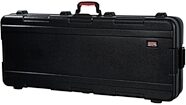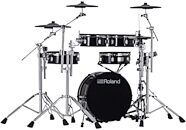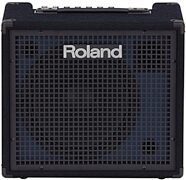Clavia Nord Modular G2X 61-Key Modeling Synthesizer
No longer available at zZounds

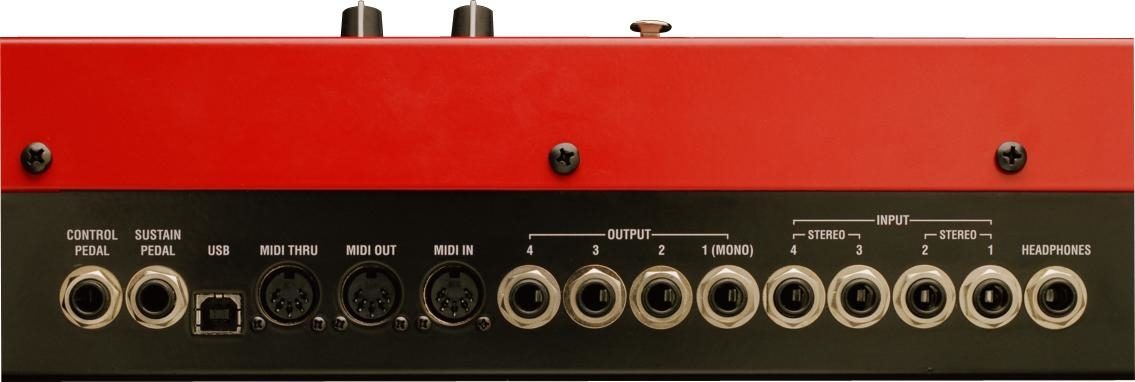
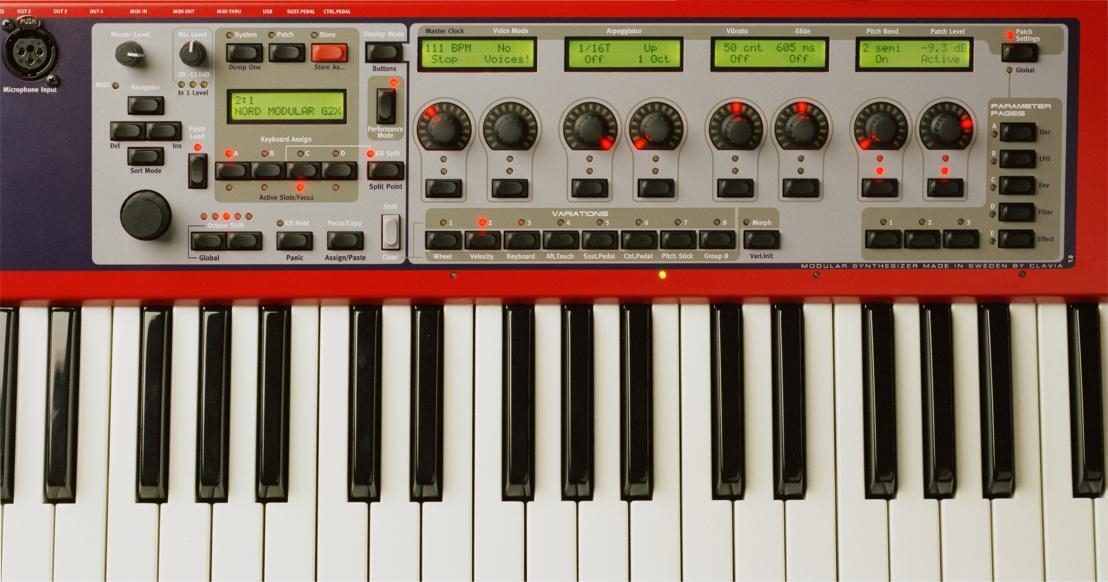

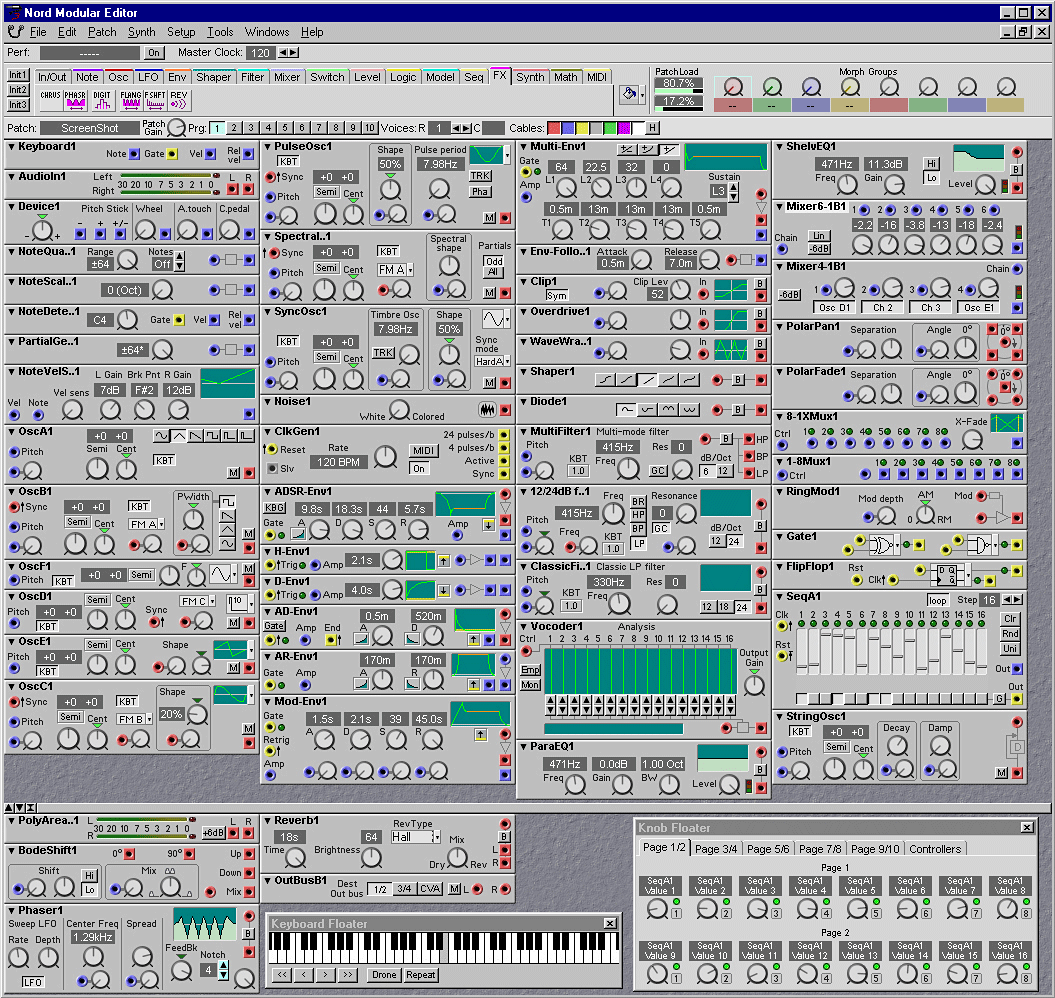
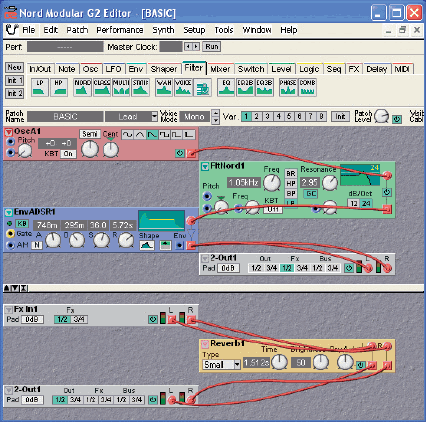
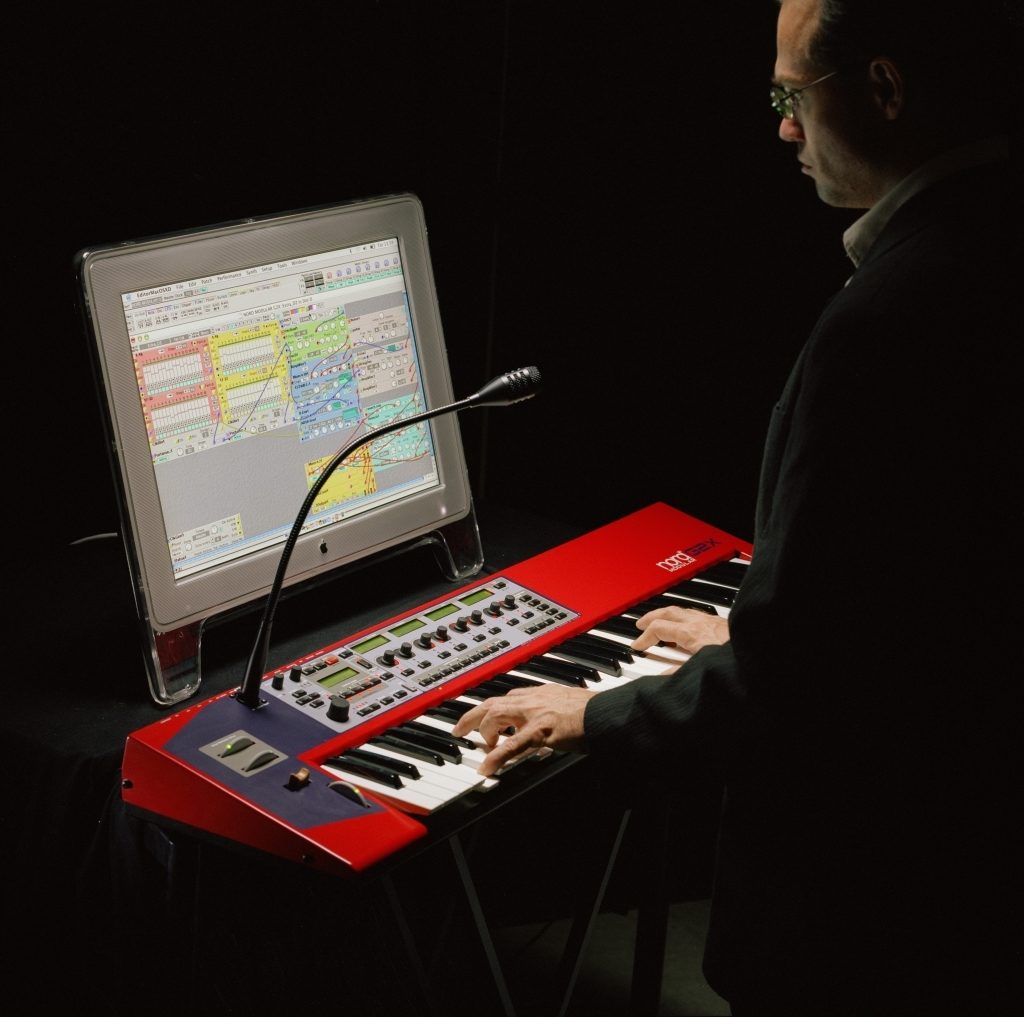
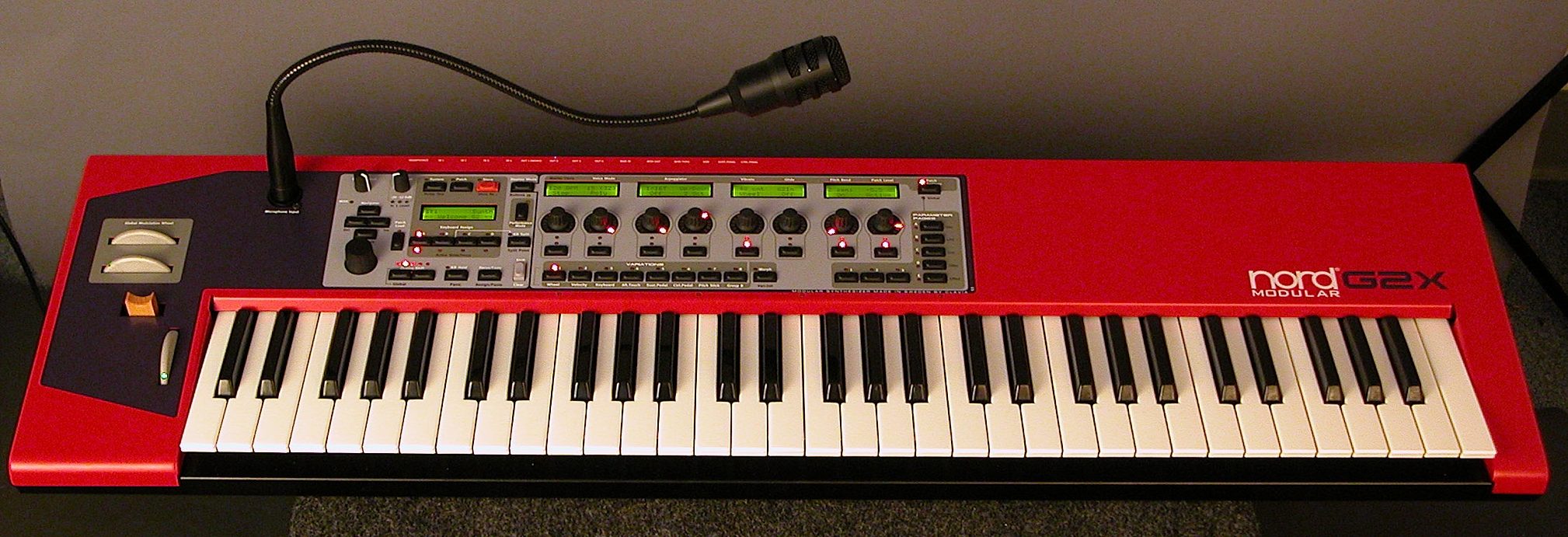
zZounds Gear Experts Say...
Live performance-focused features. Intuitive software editing.
Overview
No doubt, computers have become a natural part of today's music production. The process of editing sounds and sequences is so much easier from a computer screen. Still keyboard players feel the need for portable instruments.
Clavia proudly presents the second generation of the Nord Modular -- the Nord Modular G2. Nord Modular G2 offers you the better of two worlds and provides an effective solution for the working musician. With the G2, Clavia introduces a truly innovative hardware platform with focus on live performance features. The G2 offers fully assignable controllers to turn, bend and tweak. In fact, the ultra-flexible user interface of the G2 takes real-time editing to a higher level.
While remaining true to the traditional modular synthesis concept it manages to go where no modular synthesizer has ever gone before.
G2X is the big brother of the G2 series and offers the same features as the Nord Modular G2 with a few extras. The keyboard has five instead of three octaves. Moreover, the keys are semiweighted for more sensitivity to the touch. It's fitted from the start with a voice expansion board offering twice the processing power compared to its little brothers (G2 and G2 engine). It holds two extra freely assignable modulation wheels. All three wheels are equipped with LED's to indicate their position. Furthermore, the G2X is delivered with a goose neck microphone that you connect onto the top panel.
The Nord Modular G2X combines the ultimate tone flexibility of… read more the Nord Modular G2 and the Nord Modular G2 engine with previously unavailable opportunities using these amazing instruments on stage.
New features in the G2X
Five octave semi-weighted keyboard for more sensitive touch
Voice expansion board with twice the processing power
Two additional easily assignable modulation wheels
All modulation wheels with led for clear position indication
Goose neck high quality microphone easily connected onto top panel
Editor available for Mac OSX and Windows
The Nord Modular G2 concept
Technology alone cannot make good music, but provides great means to support the creation of it. Ever since the start in 1983, Clavia has continuously had the ambition to facilitate the working lives of musicians, composers and producers. When introducing the first Nord Modular synthesizer in 1997 Clavia took an important step in that process. With the award-winning Nord Modular system you can develop sounds similarly to those created by old analog patch synthesizers. You build up the sound piece by piece on the computer screen in a simple and intuitive way following your desired signal flow. To get a feel for how it works, consider the way a guitarist connects his boxes and pedals.
The G2 provides a wide spectrum of modules spanning from traditional synthesizer building blocks such as oscillators, filters and envelope generators to modern effect processors plus an array of special purpose modules such as vocoder, pitch tracker and physical modeling. You can also build your own unique FX processors and run both internal and external signals through them. Future upgrades will include new modules available for free from Clavia. All together this makes the G2 a powerful tool, enabling you to create totally unique as well as traditional sounds.
Studio or Stage
Although the G2 is a very complex instrument, Clavia doesn't compromise on simplicity. Technical complexity is essential to the musical possibilities. Simplicity demands a well thought-out user interface. Clavia aims to be functional in a simple way, yet technically fulfilled, which you are about to find out no matter whether you're performing live or work in a studio environment.
The G2 offers a number of previously unavailable opportunities particularly suitable for those of you performing live on stage. Just disconnect your synth from the PC / Mac and use it as a freestanding instrument. Whether you want to play traditional synth patches or control step sequencers in real-time or make cool sounds with delays, reverb and audio processing, the G2 offers plenty of knobs and controllers to tweak! The G2 conforms exactly to your needs letting you assign all controllers, inputs and outputs the way you want them. The fantastic Morph capabilities on the G2 offer enormous sonic variations. The G2's 8 Morph groups per patch let you control sets of parameters from single internal control sources and via MIDI. In fact, the pitch stick on the G2 can also be used to control an entire Morph group!
Four analog audio inputs including an XLR mic input with built-in amplifier give you plenty of room for inserting external signals and patching them. For example, you could plug in four external audio sources (or two stereo if you like) and mix and process the audio through various FX modules of the G2. Or plug in a microphone in the XLR input and use the great vocoder module for vocal adventures. Furthermore, tweaking a step sequencer will be a lot of fun and extremely easy thanks to the real-time editing controls and the visual feedback from the LCDs. The crystal clear 24-bit, 96 kHz A / D and D / A converters on the G2 ensure the highest possible audio quality!
Let the G2 become the brain of your studio or your live keyboard rig.
Nord Modular G2 Editor
The G2 Editor is a joy to work with. When you start building a new patch in the G2 computer editor you will see an empty desktop area divided into three major sections; the voice area, the FX area and the toolbar. The voice area is the polyphonic part of the system and it is here you drag and drop your basic synthesizer building blocks, which Clavia calls modules. They are categorized under different tabs in the toolbar. Connect the modules you have placed on the desktop with virtual cables. In the lower section, the monophonic FX area, you drag modules mainly used for the effect part of your patch such as delay, reverb and so on. Tweak the knobs and buttons to refine the sound you have created.
The G2 editor offers user-defined coloring of modules and color-coded module groups to make it easy to patch and layout your sounds. Most of the modules are self-optimizing, meaning that they adapt their DSP load to the patched signal type and used connections. This opens up for bigger patches and greater polyphony. When you are finished with your patching the next step would be to assign various parameters of your choice to the hardware knobs, buttons and controllers. Whether you want to do morphing or just want to assign parameters to the synth, Clavia made it easy for you -- super fast drag and drop and you are ready to go. When you are finished patching, just disconnect the G2 from the computer and bring it to your gig. All your sounds reside in the G2 and are retrievable with just a push of a button.
The Modular System
The modular system consists of a hardware synthesizer and a Mac / PC software editor. When connected to each other via USB, the software editor and the instrument work seamlessly together, perfectly synchronized.
Modular synthesis -- freely configurable sound architecture. Combine building blocks called Modules into a sound, here referred to as a Patch. The modules can be connected to each other in any desired structure, virtually without limitations. Some modules generate sounds and some of them are processing sounds. The modules support well-known synthesis techniques such as subtractive, additive, FM, physical modeling, FX processing or any combination thereof.
Each Patch works as an individual and independent synthesizer. A patch is divided into two sections: the Voice area (VA) holds the polyphonic part of the sound; the Effect area (FX) holds the monophonic part of the sound. The 8 variations per patch let you store and recall multiple, favorite settings of every patch with the push of a button.
Over 160 sound modules are organized in 16 categories: in / out, note, oscillator, LFO, random, envelope, shaper, filter, mixer, switch, level, logic, sequencer, FX, delay, and MIDI.
(See the complete list of modules for reference on all the available ones.)
Hight-quality audio comes from true 24 bit processing system with 96 kHz sampling rate.
There are 4 channels of audio from voice area to effect area; 4 channels of audio between the 4 patches in a performance; 4 channels/buses of audio to physical output connectors of the instrument (freely assignable); 4 channels/buses of audio input.
The G2 offers totally free configuration of effects and signal routing via the dedicated effect area. Among the available modules are the ones usually found in effect processors, such as reverb, chorus, flanger, EQ, pitch shifter, compressor, noise gates and delays.
Available Modules
In / out group: 2 output, 4 output, 2 input, 4 input, FX area in, keyboard voice, keyboard mono, device, status, note detection, name bar
Note group: note quantizer, key quantizer, partial quantizer, note scaler, glide, pitch tracker, zero crossing counter, level scaler
Oscillator group: oscillator A, oscillator B, oscillator C, oscillator D, phase modulation oscillator, shape oscillator A, shape oscillator B, dual oscillator, string oscillator, percussion oscillator, noise generator, metallic noise oscillator, noise oscillator, master oscillator, drum synth, FM operator, DX router
LFO group: LFO A, LFO B, LFO C, shape, LFO A, clock generator
Random group: random A, random B, random clock A, random clock B, random trig, random pattern
Envelope group: ADSR envelope, hold envelope, decay envelope, AD / R envelope, AHD envelope, ADDSR envelope, multi stage envelope, AHD-mod envelope, ADSR-mod envelope
Filter group: LP 6-36 dB / octave, HP 6-36 dB / octave, Nord 12 / 24 dB / octave, classic LP 12 / 18 / 24 dB / octave, multi filter 6 / 12 dB / octave, static 12 dB / octave, wah-wah, voice filter, vocoder, EQ peak, EQ 2 band, EQ 3 band, phase filter, comb filter
Shaper group: clip, overdrive saturation, expression shaper, wavewrapper, static shaper, rectifier
Mixer group: 1-1 mixer with level + on / off, 1-1 stereo mixer with level, 2-1 mixer with level + on / off, 2-1 mixer with level + inv, 4-1 mixer, 4-1 mixer with level, 4-1 mixer with level + on / off, 4-1 stereo mixer with level + on / off, 8-1 mixer, 8-1 mixer with level, 8-1 fader with level + on / off, 6-1 stereo mixer with level+pan, pan, cross-fader, 1 to 2 fader, 2 to 1 fader
Switch: momentary on / off, toggling on / off, momentary 2-1 switch, 2-1 switch, 4-1 switch, 8-1 switch, momentary 1-2 switch, 1-2 switch, 1-4 switch, 1-8 switch, 2-1 value switch, 1-2 value switch, window switch, 8-1 multiplexer, 1-8 multiplexer, 8-1 multiplexer w/crossfade, sample & hold, track & hold
Level group: constant, momentary constant switch, toggling constant switch, level add, level converter, level amplifier, level multiplier, level modulator, envelope follower, noise gate, compare to level, compare to signal, compare min / max, modulation amount
Logic group: gate, logic inverter, flip flop, clock divider, clock divider fixed, pulse, logic delay, 8 counter, binary counter, AD converter, DA converter
Sequencer group: event sequencer, value sequencer, level sequencer, note sequencer, control sequencer
FX group: stereo chorus, phaser, flanger, digitizer, frequency shifter, pitch shifter, scratch, reverb, compressor
Delay group: static delay, single delay, 2 tap delay, 4 tap delay, 8 tap delay, shift register, clocked delay, delay A, delay B, stereo delay
MIDI group: MIDI control send, MIDI program change send, MIDI note send, MIDI control receive, MIDI note receive, MIDI note zone, MIDI control automate
Voicing
Performances -- a performance consists of up to 4 patches together with information about MIDI settings, layers, splits, etc.
Multitimbrality -- features Clavia's classical slot concept. the instrument is divided into 4 slots (edit buffers A to D) with the possibility of holding one patch in each one of them independently, thus up to 4 patches can sound simultaneously.
Layering / splitting -- easy assign of layers and split points with the dedicated buttons on the synth's top panel. The G2 lets you work with configurations for MIDI channels, layers and splits individually for every slot / patch. This can be done either in patch mode (single) or in performance mode (multi). With the split point button you can create up to 4 split points either freely assigned or set to the 4 predefined LEDs along the keyboard.
Polyphony -- maximum of 32 voices depending on complexity (number of modules used and how they are combined). For the G2X the minimum is 7 voices (8 if the effect area is unused).
Sound Storage
Synthesizer -- a dynamic file system that contains 6 MB of flash memory dedicated for patches and performances, with the maximum capacity of holding 32 banks divided into 128 memory locations for patches.The 8 banks are divided into 128 locations for performances.
Editor Software -- built-in patch browser enables fast access to patches stored on the computer hard drive as well as the synthesizer's internal file system, which simplifies the organization of files (moving/deleting/adding). Consequently you can store as many patches and performances as you want (the only restriction is the capacity of your computer's hard drive). The bank upload / download dialog allows for quick transfers / backups of complete banks of patches between your computer and synthesizer.
File Size -- small sized patch files (an average of 3 kilobytes) make it easy to share and store patches.
Morphing
Clavia's well-known morphing technology makes it easy to control multiple parameters from one source (e.g. modulation wheel, aftertouch) with the possibility to set the range for each parameter individually.
Available sources: 3 modulation wheels, velocity, keyboard range, aftertouch, control pedal, sustain pedal, pitch stick or any of the eight top panel rotary encoders.
Parameter Pages
An interface that gives you instant access to all parameters in the patch architecture, either from the synthesizer's top panel or from the software editor.
Hardware support -- extremely easy from the synth's top panel with 15 pages organized in 5 rows (1 to 5) and 3 columns (A to C). From each page you can control parameters with the 8 dedicated rotary encoders, mounted together with 4 displays that show all parameter information.
Page modes -- in single patch mode, parameter pages are linked to one specific patch. Global mode is for controlling parameters in all 4 slots from the same page.
Editor Software
User interface -- a tab system organizes available modules in an easy and accessible way. There are computer keyboard shortcuts for most vital functions. A fast intuitive user interface that utilizes drag & drop for most tasks such as selecting, placing, moving and connecting modules or assigning parameters to the parameter pages. There is a multiple undo / redo function, custom colors of individual modules for easy overview of patches, a fast replace function for modules that keeps track of connections and parameter settings, a list of recent files, and a hide / show groups feature for keeping track of connections and cables. The instant hint views system displays configurations of MIDI CCs (continuos controllers), morph programming and assigned parameters.
Online help -- an integrated help system with index and search functions brings you answers to your questions with the touch of a button.
Tools -- In addition to the patch browser and bank upload/download dialog tools (see sound storage), there is a virtual keyboard that lets you play the sound directly from the editor. The notepad lets you store reminders, etc. together with your work.
MIDI Implementation
External: 16 MIDI channels via MIDI In, Out and Thru. Note on / off, aftertouch, pitch bend, program change, MIDI CC (freely assignable to any parameter), SysEx dump and bank select.
Internal: MIDI can be internally routed from one slot to an other via internal virtual MIDI connections (e.g. slot A sequencers can play a slot B patch).
MIDI Sync: MIDI clock sync and song position pointers let you control delays, LFO and sequencer modules. The G2 can function as a master clock for external gear.
Extras: except for normal MIDI functions, the G2 can produce and process MIDI information on any channel (regardless of the slot's main channel) through a set of specially designed MIDI processing modules. It also supports MIDI automation of external gear from its front panel using the module "MIDI control automate."
G2X Physical Features
5-octaves, semi-weighted keyboard.
3 modulation wheels with built in LEDs.
Top-panel-mounted XLR mic input.
Shipped with gooseneck microphone.
Shipped with a built in voice expansion, thus delivering twice the processing power as the 3-octave G2 and Engine.
Synthesizer Controllers
Modulation wheels: 3 modulation wheels with extra built in LEDs.
Pitch stick: Clavia's famous, patented high-resolution pitch stick.
Keyboard: 5 octave semi-weighted keyboard with aftertouch.
Octave shift: 2 dedicated, easily accessible buttons extend the range of the built-in keyboard.
Keyboard hold: makes every note you play sustain until you press a new key.
Synthesizer Panel
Parameter pages: 5 page buttons and 3 column buttons provide real-time tweaking of up to 120 parameters.
Patch / menu navigation: rotary dial and 4 navigation buttons for rapid access to patches and performances.
Slot control: 4 slot buttons facilitate working with 4 patches simultaneously.
Morphing: programming can be done with drag & drop on the software editor or by pressing two buttons on the synth's top panel. 8 morph buttons let you assign parameters to eight different control sources for every patch.
Variations: instant recall of 8 variations per patch via 8 dedicated buttons.
Keyboard Split: intelligent split interface via keyboard split and the 4 slot buttons. 4 fixed LEDs along the keyboard indicate the position of the split points (split points can also be freely assigned).
System Settings: system, patch and store buttons for access to all system- and patch-related menus and saving procedures.
MIDI indicator: flashes when MIDI information is received or transmitted
Microphone level: with the mic level knob you can adjust the incoming signal of a microphone connected to the built in XLR jack. A built in meter with LEDs visualizes the incoming signal level.
Connections
MIDI: In, Out and Thru.
Audio inputs: 4 analog audio inputs, line-level, 24-bit ADCs, 96 kHz sampling rate. 1 XLR microphone input with built in preamp (uses one of the audio inputs).
Audio Outputs: 4 individual user configurable outputs, line-level, 24-bit DACs, 96 kHz sampling rate. 1 headphones output.
Editor communication: USB 1.1 port.
External controllers: 1 control pedal jack. 1 Sustain Pedal jack. (Both pedals can also double as morph sources.)
Power Supply: built-in power supply. Connect with enclosed standard AC-cord.
Physical Data
Dimensions: 39.6 in.(W) 11.6 in.(D) 4.1 in.(H), 1007(W) 294(D) 104(H) mm
Weight: 18.07 lbs., 8.2 kg
What's in the box: 1 USB cable, 1 power cable, CD Rom with software and sound libraries, printed manual with more than 200 pages, gooseneck microphone.
Software Upgrade Policy
Clavia offers every G2 customer free upgrades for both the editor software and the synthesizer's operating system as well as free access to future sound libraries.
System Requirements
Mac OS X:
-- Mac G3 400 MHz or better.
-- Memory: 128 MB RAM or more.
-- Mac OSX 10.2 (or later).
-- Screen resolution: at least 800x600 (optimized for 1024x768 or higher).
-- Screen colors: 16 bit (more than 65000 colors).
-- USB 1.1 or higher
Windows:
-- Intel Pentium II 500 Mhz or better.
-- Memory: 128 MB RAM or more.
-- Microsoft Windows 98SE/2000/XP.
-- Screen resolution: at least 800x600 (optimized for 1024x768 or higher).
-- Screen colors: 16 bit (more than 65000 colors).
-- USB 1.1 or higher. read less
Clavia proudly presents the second generation of the Nord Modular -- the Nord Modular G2. Nord Modular G2 offers you the better of two worlds and provides an effective solution for the working musician. With the G2, Clavia introduces a truly innovative hardware platform with focus on live performance features. The G2 offers fully assignable controllers to turn, bend and tweak. In fact, the ultra-flexible user interface of the G2 takes real-time editing to a higher level.
While remaining true to the traditional modular synthesis concept it manages to go where no modular synthesizer has ever gone before.
G2X is the big brother of the G2 series and offers the same features as the Nord Modular G2 with a few extras. The keyboard has five instead of three octaves. Moreover, the keys are semiweighted for more sensitivity to the touch. It's fitted from the start with a voice expansion board offering twice the processing power compared to its little brothers (G2 and G2 engine). It holds two extra freely assignable modulation wheels. All three wheels are equipped with LED's to indicate their position. Furthermore, the G2X is delivered with a goose neck microphone that you connect onto the top panel.
The Nord Modular G2X combines the ultimate tone flexibility of… read more the Nord Modular G2 and the Nord Modular G2 engine with previously unavailable opportunities using these amazing instruments on stage.
New features in the G2X
Five octave semi-weighted keyboard for more sensitive touch
Voice expansion board with twice the processing power
Two additional easily assignable modulation wheels
All modulation wheels with led for clear position indication
Goose neck high quality microphone easily connected onto top panel
Editor available for Mac OSX and Windows
The Nord Modular G2 concept
Technology alone cannot make good music, but provides great means to support the creation of it. Ever since the start in 1983, Clavia has continuously had the ambition to facilitate the working lives of musicians, composers and producers. When introducing the first Nord Modular synthesizer in 1997 Clavia took an important step in that process. With the award-winning Nord Modular system you can develop sounds similarly to those created by old analog patch synthesizers. You build up the sound piece by piece on the computer screen in a simple and intuitive way following your desired signal flow. To get a feel for how it works, consider the way a guitarist connects his boxes and pedals.
The G2 provides a wide spectrum of modules spanning from traditional synthesizer building blocks such as oscillators, filters and envelope generators to modern effect processors plus an array of special purpose modules such as vocoder, pitch tracker and physical modeling. You can also build your own unique FX processors and run both internal and external signals through them. Future upgrades will include new modules available for free from Clavia. All together this makes the G2 a powerful tool, enabling you to create totally unique as well as traditional sounds.
Studio or Stage
Although the G2 is a very complex instrument, Clavia doesn't compromise on simplicity. Technical complexity is essential to the musical possibilities. Simplicity demands a well thought-out user interface. Clavia aims to be functional in a simple way, yet technically fulfilled, which you are about to find out no matter whether you're performing live or work in a studio environment.
The G2 offers a number of previously unavailable opportunities particularly suitable for those of you performing live on stage. Just disconnect your synth from the PC / Mac and use it as a freestanding instrument. Whether you want to play traditional synth patches or control step sequencers in real-time or make cool sounds with delays, reverb and audio processing, the G2 offers plenty of knobs and controllers to tweak! The G2 conforms exactly to your needs letting you assign all controllers, inputs and outputs the way you want them. The fantastic Morph capabilities on the G2 offer enormous sonic variations. The G2's 8 Morph groups per patch let you control sets of parameters from single internal control sources and via MIDI. In fact, the pitch stick on the G2 can also be used to control an entire Morph group!
Four analog audio inputs including an XLR mic input with built-in amplifier give you plenty of room for inserting external signals and patching them. For example, you could plug in four external audio sources (or two stereo if you like) and mix and process the audio through various FX modules of the G2. Or plug in a microphone in the XLR input and use the great vocoder module for vocal adventures. Furthermore, tweaking a step sequencer will be a lot of fun and extremely easy thanks to the real-time editing controls and the visual feedback from the LCDs. The crystal clear 24-bit, 96 kHz A / D and D / A converters on the G2 ensure the highest possible audio quality!
Let the G2 become the brain of your studio or your live keyboard rig.
Nord Modular G2 Editor
The G2 Editor is a joy to work with. When you start building a new patch in the G2 computer editor you will see an empty desktop area divided into three major sections; the voice area, the FX area and the toolbar. The voice area is the polyphonic part of the system and it is here you drag and drop your basic synthesizer building blocks, which Clavia calls modules. They are categorized under different tabs in the toolbar. Connect the modules you have placed on the desktop with virtual cables. In the lower section, the monophonic FX area, you drag modules mainly used for the effect part of your patch such as delay, reverb and so on. Tweak the knobs and buttons to refine the sound you have created.
The G2 editor offers user-defined coloring of modules and color-coded module groups to make it easy to patch and layout your sounds. Most of the modules are self-optimizing, meaning that they adapt their DSP load to the patched signal type and used connections. This opens up for bigger patches and greater polyphony. When you are finished with your patching the next step would be to assign various parameters of your choice to the hardware knobs, buttons and controllers. Whether you want to do morphing or just want to assign parameters to the synth, Clavia made it easy for you -- super fast drag and drop and you are ready to go. When you are finished patching, just disconnect the G2 from the computer and bring it to your gig. All your sounds reside in the G2 and are retrievable with just a push of a button.
The Modular System
The modular system consists of a hardware synthesizer and a Mac / PC software editor. When connected to each other via USB, the software editor and the instrument work seamlessly together, perfectly synchronized.
Modular synthesis -- freely configurable sound architecture. Combine building blocks called Modules into a sound, here referred to as a Patch. The modules can be connected to each other in any desired structure, virtually without limitations. Some modules generate sounds and some of them are processing sounds. The modules support well-known synthesis techniques such as subtractive, additive, FM, physical modeling, FX processing or any combination thereof.
Each Patch works as an individual and independent synthesizer. A patch is divided into two sections: the Voice area (VA) holds the polyphonic part of the sound; the Effect area (FX) holds the monophonic part of the sound. The 8 variations per patch let you store and recall multiple, favorite settings of every patch with the push of a button.
Over 160 sound modules are organized in 16 categories: in / out, note, oscillator, LFO, random, envelope, shaper, filter, mixer, switch, level, logic, sequencer, FX, delay, and MIDI.
(See the complete list of modules for reference on all the available ones.)
Hight-quality audio comes from true 24 bit processing system with 96 kHz sampling rate.
There are 4 channels of audio from voice area to effect area; 4 channels of audio between the 4 patches in a performance; 4 channels/buses of audio to physical output connectors of the instrument (freely assignable); 4 channels/buses of audio input.
The G2 offers totally free configuration of effects and signal routing via the dedicated effect area. Among the available modules are the ones usually found in effect processors, such as reverb, chorus, flanger, EQ, pitch shifter, compressor, noise gates and delays.
Available Modules
In / out group: 2 output, 4 output, 2 input, 4 input, FX area in, keyboard voice, keyboard mono, device, status, note detection, name bar
Note group: note quantizer, key quantizer, partial quantizer, note scaler, glide, pitch tracker, zero crossing counter, level scaler
Oscillator group: oscillator A, oscillator B, oscillator C, oscillator D, phase modulation oscillator, shape oscillator A, shape oscillator B, dual oscillator, string oscillator, percussion oscillator, noise generator, metallic noise oscillator, noise oscillator, master oscillator, drum synth, FM operator, DX router
LFO group: LFO A, LFO B, LFO C, shape, LFO A, clock generator
Random group: random A, random B, random clock A, random clock B, random trig, random pattern
Envelope group: ADSR envelope, hold envelope, decay envelope, AD / R envelope, AHD envelope, ADDSR envelope, multi stage envelope, AHD-mod envelope, ADSR-mod envelope
Filter group: LP 6-36 dB / octave, HP 6-36 dB / octave, Nord 12 / 24 dB / octave, classic LP 12 / 18 / 24 dB / octave, multi filter 6 / 12 dB / octave, static 12 dB / octave, wah-wah, voice filter, vocoder, EQ peak, EQ 2 band, EQ 3 band, phase filter, comb filter
Shaper group: clip, overdrive saturation, expression shaper, wavewrapper, static shaper, rectifier
Mixer group: 1-1 mixer with level + on / off, 1-1 stereo mixer with level, 2-1 mixer with level + on / off, 2-1 mixer with level + inv, 4-1 mixer, 4-1 mixer with level, 4-1 mixer with level + on / off, 4-1 stereo mixer with level + on / off, 8-1 mixer, 8-1 mixer with level, 8-1 fader with level + on / off, 6-1 stereo mixer with level+pan, pan, cross-fader, 1 to 2 fader, 2 to 1 fader
Switch: momentary on / off, toggling on / off, momentary 2-1 switch, 2-1 switch, 4-1 switch, 8-1 switch, momentary 1-2 switch, 1-2 switch, 1-4 switch, 1-8 switch, 2-1 value switch, 1-2 value switch, window switch, 8-1 multiplexer, 1-8 multiplexer, 8-1 multiplexer w/crossfade, sample & hold, track & hold
Level group: constant, momentary constant switch, toggling constant switch, level add, level converter, level amplifier, level multiplier, level modulator, envelope follower, noise gate, compare to level, compare to signal, compare min / max, modulation amount
Logic group: gate, logic inverter, flip flop, clock divider, clock divider fixed, pulse, logic delay, 8 counter, binary counter, AD converter, DA converter
Sequencer group: event sequencer, value sequencer, level sequencer, note sequencer, control sequencer
FX group: stereo chorus, phaser, flanger, digitizer, frequency shifter, pitch shifter, scratch, reverb, compressor
Delay group: static delay, single delay, 2 tap delay, 4 tap delay, 8 tap delay, shift register, clocked delay, delay A, delay B, stereo delay
MIDI group: MIDI control send, MIDI program change send, MIDI note send, MIDI control receive, MIDI note receive, MIDI note zone, MIDI control automate
Voicing
Performances -- a performance consists of up to 4 patches together with information about MIDI settings, layers, splits, etc.
Multitimbrality -- features Clavia's classical slot concept. the instrument is divided into 4 slots (edit buffers A to D) with the possibility of holding one patch in each one of them independently, thus up to 4 patches can sound simultaneously.
Layering / splitting -- easy assign of layers and split points with the dedicated buttons on the synth's top panel. The G2 lets you work with configurations for MIDI channels, layers and splits individually for every slot / patch. This can be done either in patch mode (single) or in performance mode (multi). With the split point button you can create up to 4 split points either freely assigned or set to the 4 predefined LEDs along the keyboard.
Polyphony -- maximum of 32 voices depending on complexity (number of modules used and how they are combined). For the G2X the minimum is 7 voices (8 if the effect area is unused).
Sound Storage
Synthesizer -- a dynamic file system that contains 6 MB of flash memory dedicated for patches and performances, with the maximum capacity of holding 32 banks divided into 128 memory locations for patches.The 8 banks are divided into 128 locations for performances.
Editor Software -- built-in patch browser enables fast access to patches stored on the computer hard drive as well as the synthesizer's internal file system, which simplifies the organization of files (moving/deleting/adding). Consequently you can store as many patches and performances as you want (the only restriction is the capacity of your computer's hard drive). The bank upload / download dialog allows for quick transfers / backups of complete banks of patches between your computer and synthesizer.
File Size -- small sized patch files (an average of 3 kilobytes) make it easy to share and store patches.
Morphing
Clavia's well-known morphing technology makes it easy to control multiple parameters from one source (e.g. modulation wheel, aftertouch) with the possibility to set the range for each parameter individually.
Available sources: 3 modulation wheels, velocity, keyboard range, aftertouch, control pedal, sustain pedal, pitch stick or any of the eight top panel rotary encoders.
Parameter Pages
An interface that gives you instant access to all parameters in the patch architecture, either from the synthesizer's top panel or from the software editor.
Hardware support -- extremely easy from the synth's top panel with 15 pages organized in 5 rows (1 to 5) and 3 columns (A to C). From each page you can control parameters with the 8 dedicated rotary encoders, mounted together with 4 displays that show all parameter information.
Page modes -- in single patch mode, parameter pages are linked to one specific patch. Global mode is for controlling parameters in all 4 slots from the same page.
Editor Software
User interface -- a tab system organizes available modules in an easy and accessible way. There are computer keyboard shortcuts for most vital functions. A fast intuitive user interface that utilizes drag & drop for most tasks such as selecting, placing, moving and connecting modules or assigning parameters to the parameter pages. There is a multiple undo / redo function, custom colors of individual modules for easy overview of patches, a fast replace function for modules that keeps track of connections and parameter settings, a list of recent files, and a hide / show groups feature for keeping track of connections and cables. The instant hint views system displays configurations of MIDI CCs (continuos controllers), morph programming and assigned parameters.
Online help -- an integrated help system with index and search functions brings you answers to your questions with the touch of a button.
Tools -- In addition to the patch browser and bank upload/download dialog tools (see sound storage), there is a virtual keyboard that lets you play the sound directly from the editor. The notepad lets you store reminders, etc. together with your work.
MIDI Implementation
External: 16 MIDI channels via MIDI In, Out and Thru. Note on / off, aftertouch, pitch bend, program change, MIDI CC (freely assignable to any parameter), SysEx dump and bank select.
Internal: MIDI can be internally routed from one slot to an other via internal virtual MIDI connections (e.g. slot A sequencers can play a slot B patch).
MIDI Sync: MIDI clock sync and song position pointers let you control delays, LFO and sequencer modules. The G2 can function as a master clock for external gear.
Extras: except for normal MIDI functions, the G2 can produce and process MIDI information on any channel (regardless of the slot's main channel) through a set of specially designed MIDI processing modules. It also supports MIDI automation of external gear from its front panel using the module "MIDI control automate."
G2X Physical Features
5-octaves, semi-weighted keyboard.
3 modulation wheels with built in LEDs.
Top-panel-mounted XLR mic input.
Shipped with gooseneck microphone.
Shipped with a built in voice expansion, thus delivering twice the processing power as the 3-octave G2 and Engine.
Synthesizer Controllers
Modulation wheels: 3 modulation wheels with extra built in LEDs.
Pitch stick: Clavia's famous, patented high-resolution pitch stick.
Keyboard: 5 octave semi-weighted keyboard with aftertouch.
Octave shift: 2 dedicated, easily accessible buttons extend the range of the built-in keyboard.
Keyboard hold: makes every note you play sustain until you press a new key.
Synthesizer Panel
Parameter pages: 5 page buttons and 3 column buttons provide real-time tweaking of up to 120 parameters.
Patch / menu navigation: rotary dial and 4 navigation buttons for rapid access to patches and performances.
Slot control: 4 slot buttons facilitate working with 4 patches simultaneously.
Morphing: programming can be done with drag & drop on the software editor or by pressing two buttons on the synth's top panel. 8 morph buttons let you assign parameters to eight different control sources for every patch.
Variations: instant recall of 8 variations per patch via 8 dedicated buttons.
Keyboard Split: intelligent split interface via keyboard split and the 4 slot buttons. 4 fixed LEDs along the keyboard indicate the position of the split points (split points can also be freely assigned).
System Settings: system, patch and store buttons for access to all system- and patch-related menus and saving procedures.
MIDI indicator: flashes when MIDI information is received or transmitted
Microphone level: with the mic level knob you can adjust the incoming signal of a microphone connected to the built in XLR jack. A built in meter with LEDs visualizes the incoming signal level.
Connections
MIDI: In, Out and Thru.
Audio inputs: 4 analog audio inputs, line-level, 24-bit ADCs, 96 kHz sampling rate. 1 XLR microphone input with built in preamp (uses one of the audio inputs).
Audio Outputs: 4 individual user configurable outputs, line-level, 24-bit DACs, 96 kHz sampling rate. 1 headphones output.
Editor communication: USB 1.1 port.
External controllers: 1 control pedal jack. 1 Sustain Pedal jack. (Both pedals can also double as morph sources.)
Power Supply: built-in power supply. Connect with enclosed standard AC-cord.
Physical Data
Dimensions: 39.6 in.(W) 11.6 in.(D) 4.1 in.(H), 1007(W) 294(D) 104(H) mm
Weight: 18.07 lbs., 8.2 kg
What's in the box: 1 USB cable, 1 power cable, CD Rom with software and sound libraries, printed manual with more than 200 pages, gooseneck microphone.
Software Upgrade Policy
Clavia offers every G2 customer free upgrades for both the editor software and the synthesizer's operating system as well as free access to future sound libraries.
System Requirements
Mac OS X:
-- Mac G3 400 MHz or better.
-- Memory: 128 MB RAM or more.
-- Mac OSX 10.2 (or later).
-- Screen resolution: at least 800x600 (optimized for 1024x768 or higher).
-- Screen colors: 16 bit (more than 65000 colors).
-- USB 1.1 or higher
Windows:
-- Intel Pentium II 500 Mhz or better.
-- Memory: 128 MB RAM or more.
-- Microsoft Windows 98SE/2000/XP.
-- Screen resolution: at least 800x600 (optimized for 1024x768 or higher).
-- Screen colors: 16 bit (more than 65000 colors).
-- USB 1.1 or higher. read less
No longer available at zZounds
In most cases, a product is unavailable because it has been discontinued by the manufacturer
This is a carousel with product cards. Use the previous and next buttons to navigate.









